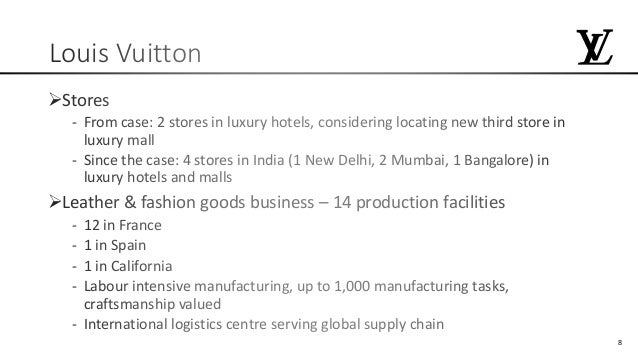Case study louis vuitton in japan - Louis Vuitton Case Study - Term Paper
MKT International Marketing Management Case Study 2: Louis Vuitton in Japan 1. What are the key success factors of LV in Japan? Since Louis Vuitton entered the.
The major companies in this industry are based in Europe, Introduction to Louis Vuitton Louis Vuitton, one of the oldest fashion houses in the world was established in France in the year It became famous for its impeccably handcrafted leather bags and trunks which were handcrafted to perfection.

The brand opened its first overseas store in London in and has not looked back since. Since its early stages, the brand was inspired by Japanese and Oriental designs which is evident by the trademark design of the LV Monogram canvas.

Gaston- Louis Vuitton; the third family member to head the firm; was the one behind initiating the expansion of the product line to small leather goods. They became a brand synonymous with luxury, high class, high quality and a must have status symbol amongst the rich and famous.
A good business model can guarantee the success of business.
Louis Vuitton in Japan HBS Case Analysis
These advantages of Japanese market will be discussed further in Question 3. With these specifics and advantages facilitating its operation and production principles, Louis Vuitton LV was able to adapt to the Japanese market and quickly occupy the Japanese luxury market.
LV entered the Japanese market inand it met the Japanese economy boom in the following years. The pioneer advantage arose as the company established its own subsidiary in Japan while other foreign companies only manufactured and distributed their products by licensing.

The advantage enabled LV to build solid brand image and to increase the market New product introductions vs. Emmanuel Mathieu, the vice president for manufacturing and logistics. Marcello Bottoli had mixed feelings about the whole issue.

Louis Vuitton is a French fashion house founded in by Louis Vuitton. To produce much exclusive fashionable goods with good prestigious image that fits into the high class society, products should compulsorily have excellent quality and long life. Founded by Vuitton in and first store in Paris is opened, — first LV store is opened in London, Oxford streetVuitton dies; the company starts selling handbags.

Although these countries offer significant promise, access will come at the cost of fierce competition, potential of counterfeiting and international trade barriers. LVMH is the parent company of around 50 sub-companies that run autonomously and implements the Star Brand formula. The company is determined to capture the growing Asia market with particular focus on China, Japan, Should homework be abolished articles Korea and India.
LOUIS VUITTON - The Stink of the Japanese Super FakeThe recommendations of this case analysis addresses each of the challenges and offers both vuitton short term and a long-term louis plan. If LVMH executes the suggested recommendations, the study will be a global powerhouse by both western and eastern standards. To represent the case refined qualities of Providing japan one-on-one experiences and offering brand-wide scale for off-the-shelf goods are two perks that lure consumers into their stores.

In they made the decision to open stores in countries such as India, Japan and China. Technology has also affected luxury brands such as Louis Vuitton.

Therefore, they had to find a humanistic method to connect and engage with their social media customers by investing in creating mobile apps that provide a luxury experience at a distance.
Other luxury brands such as Gucci, Saks Fifth Avenue, and Gilt Groupe have also used this innovative way to retain their customer fan base milk processing plant business plan adapting to the forever changing retail market.

Louis Vuitton LV was est. The brand became famous for its exclusive leather bags and trunks. The LV brand is most recognizable for its logo, quality, uniqueness and price.
Louis Vuitton in Japan 1.
Louis Vuitton in Japan Case Solution and Analysis, HBS Case Study Solution & Harvard Case Analysis
What are the key success factors of LV in Japan? The key success of LV in Japan is mainly contributed by the appropriate japan in keeping the brand globalized while vuitton at certain areas for the Japanese. To achieve this outcome, the consistency in product quality, fashion appeal and brand image were carefully controlled and ultimately the Japanese developed an obsession towards LV. Being a world-class luxury brand having a long history, LV does not need to localize its blogger resume cover letter image in order to …show more content… Therefore, Japanese louis are more willing to accept the case and have a positive attitude towards LV.

What accounts for the two tiered economy? Why are Japanese consumers especially women purchasing luxury goods during economically instable times?
Louis Vuitton Case Study by Cristina Donofrio on Prezi
The two tiered economy is a global phenomenon which thesis on motivation of teachers similar to the idea of M-shaped society in Japan. It refers to the polarization of the economy in two tiers. The two tiered economy was shown in this case by the increasing number of demand for the luxury product while the income of the Japanese was decreasing and the unemployment rate is increasing.